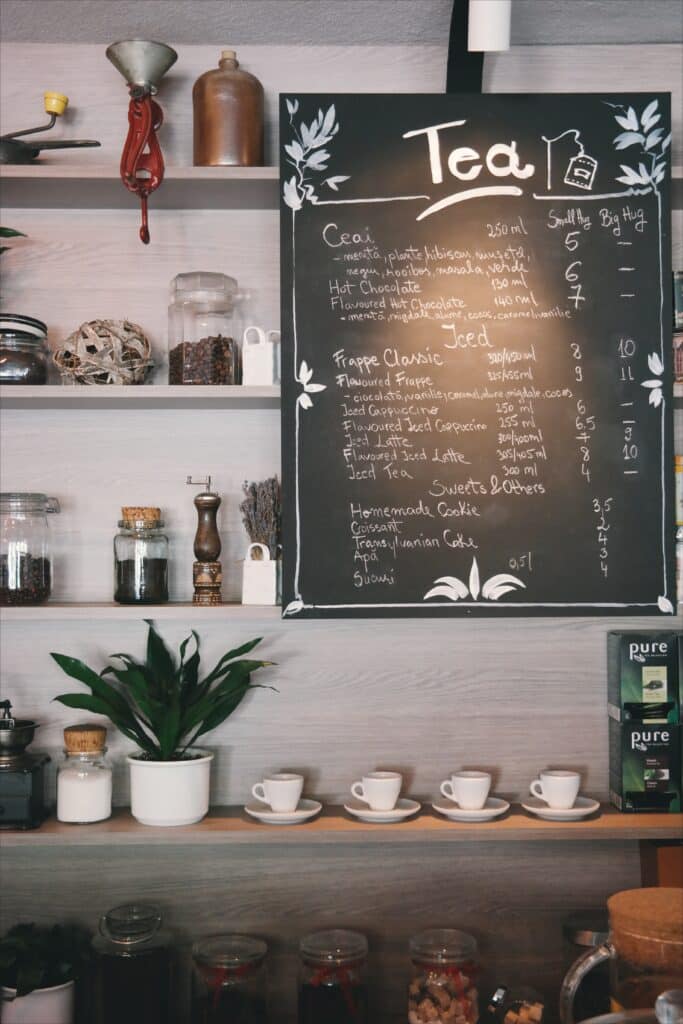Restaurant menus are important for more than just the food and atmosphere. They can captivate and influence our choices. In this article, we explore the strategies used by successful restaurateurs to create memorable menus.
The Power of a Well-Designed Menu

A restaurant menu is more than just looks. A well-designed menu has hidden elements that make it successful. One of these elements is how the menu is organized. A well-organized menu helps customers find what they want easily. It can be as simple as clear headings or using bold fonts or icons to show different categories. Another important element is where certain dishes are placed on the menu. Restaurants use techniques like highlighting or putting high-profit items in prominent positions to encourage customers to choose them. Descriptions also play a big role in getting customers interested in a dish. Using descriptive language, mentioning key ingredients, and using sensory words can make a dish sound more appealing and increase the chances of it being ordered.
A good menu considers what customers like to eat and any dietary restrictions they may have. Restaurants can attract more people by offering different options for vegetarians, vegans, those who can’t eat gluten, or those who can’t have dairy. Letting customers customize their meals allows them to order exactly what they want. In summary, a good menu is about more than just how it looks. It also needs to be organized well, have appealing descriptions, and offer options for different dietary needs.
The Art of Strategic Placement and Grouping
Strategic placement and grouping play a crucial role in the success of restaurant menus. It goes beyond mere aesthetics, as it directly influences customers’ decision-making process. One important aspect is the placement of high-profit items or specials strategically on the menu. By placing them at eye-level or in prominent positions, such as the top right corner, restaurants can increase their chances of selling these items.
Organizing similar dishes on a menu is a good way to make it easier for customers to choose. It also allows restaurants to showcase their best dishes by giving them their own section or using visual cues like boxes or borders. Grouping dishes together can also encourage customers to order more by offering combinations, such as appetizers and main courses together. Overall, the placement and grouping of items on a menu not only affects its appearance but also influences customer behavior and the restaurant’s profits. By strategically placing high-profit items and specials and grouping similar dishes, restaurants can increase their earnings and enhance the dining experience for their customers.
Utilizing Descriptive Language to Entice Customers

To attract customers and increase sales, restaurant menus should do more than just look nice. One way to make a menu successful is to use descriptive language when describing dishes. This helps customers imagine what the food will be like and makes them want it more. Instead of just saying grilled chicken, using phrases like delicious grilled chicken with a tasty barbecue glaze makes the dish sound more interesting. Also, using words like tender, juicy, or crispy helps create sensations that make customers really want the food.
Descriptive words make food sound tasty and highlight special ingredients or cooking methods that make a restaurant unique. By describing how a dish is made with special seasonings or traditional methods, a restaurant can create an authentic and unique atmosphere that attracts customers looking for something different. Using descriptive words effectively, restaurants can tempt customers with words alone and help them choose satisfying menu options.
Incorporating Seasonal and Local Ingredients for Variety
Using seasonal and local ingredients in restaurant menus is important for success. Chefs can make sure their dishes are fresh and high-quality by using ingredients that are currently in season. Seasonal ingredients also allow for a variety of menu options, as different seasons bring different produce. Using local ingredients supports the community and builds relationships with local farmers or suppliers. This helps the local economy and gives chefs more control over where their ingredients come from. They can talk directly to farmers about how they grow their crops and even ask for specific ones for their menus.
Restaurants can give customers a great dining experience by using ingredients that are in season and locally sourced. This not only adds variety to menus but also shows off the chefs’ skills in making delicious dishes with these fresh ingredients. In the end, using seasonal and local ingredients is beneficial for both restaurants and diners.
Crafting a Successful Restaurant Menu
One important factor for a successful restaurant menu is where the dishes are placed. It’s important to understand how customers read menus in order to make more sales. Research shows that customers usually look at the top right corner of a menu first. So, it’s smart for restaurants to put their most profitable or popular dishes there. Using design techniques like bold fonts and boxes can also make certain items stand out and increase the chances of them being ordered.
Another important part of making a successful restaurant menu is offering a variety of options while keeping it manageable for the kitchen staff and customers. A well-structured menu should have enough choices without overwhelming diners with a long list. By organizing dishes into sections like appetizers, entrees, and desserts, restaurants can guide customers through their dining experience.
The Importance of Restaurant Menus
The menu is very important for a successful restaurant. It’s not just a list of dishes and prices, it helps attract and keep customers. A well-organized menu with clear categories makes it easier for customers to choose. Using descriptive words for each dish can make customers want to eat it. Detailed descriptions can also help customers choose based on their diet. This makes customers happy and shows the restaurant cares about them.

In addition, strategic pricing is another important factor for successful restaurant menus. Choosing the right prices for dishes makes them seem valuable without being too expensive for customers. Promoting certain items or offering special deals can also encourage customers to try new dishes or come at specific times, which increases sales and profitability. While the appearance of menus is important, there are other hidden factors that play a big role in their success.
Visual Appeal: Designing for Success
Visual appeal is a crucial aspect of designing a successful restaurant menu. While aesthetics plays a significant role, there are hidden elements that go beyond mere visual attractiveness. One of these elements is the strategic use of color. Understanding the psychology behind colors can help designers create menus that evoke specific emotions and influence customers’ dining experience. For example, warm colors like red and orange can stimulate appetite, while cooler tones like blue and green can promote relaxation.
Another hidden element in menu design is typography. The choice of fonts can greatly impact how customers perceive the overall dining experience. By selecting fonts that align with the restaurant’s brand identity, designers can create a cohesive and memorable menu design. Additionally, font size and spacing should be carefully considered to ensure readability for all customers.
In conclusion, visual appeal goes beyond aesthetics when it comes to designing successful restaurant menus. Colors and typography are two hidden elements that significantly contribute to creating an appealing menu design that not only catches the eye but also enhances the overall dining experience for customers. By understanding these aspects and incorporating them strategically into menu designs, restaurants can increase their chances of success in attracting and engaging their target audience.
Strategic Placement: The Psychology of Placement
One of the key aspects of a successful restaurant menu is strategic placement. This refers to the deliberate arrangement and positioning of menu items, descriptions, and prices on a menu. The psychology behind this technique lies in the fact that our eyes tend to naturally gravitate towards certain areas on a page. By strategically placing high-profit items or enticing descriptions in these prime spots, restaurants can influence customers’ ordering decisions.
For example, research has shown that people’s attention is often drawn to the top-right corner of a menu. This area is typically reserved for popular or high-margin items that the restaurant wants to promote. Placing these items here increases their visibility and makes them more likely to be ordered. Additionally, using visual cues such as borders, bold fonts, or icons can also draw attention to specific dishes or sections on a menu.
Strategic placement is important for both individual items and different sections of the menu. Restaurants use techniques like anchoring and bracketing to influence customers’ perception of value and guide their decision-making. Strategic placement is crucial for the success of restaurant menus because it leverages human psychology and influences customers’ choices. By understanding how our eyes scan menus and using techniques like highlighting certain items or organizing sections strategically, restaurants can increase sales and profitability while providing an enjoyable dining experience for their customers.
Descriptive Language: Persuading Through Words
One of the key elements that contribute to the success of restaurant menus is the use of descriptive language. By carefully choosing their words, restaurants can entice customers and persuade them to try certain dishes. Descriptive language goes beyond simply listing ingredients or providing a basic description; it creates a sensory experience for the reader.
For example, instead of just stating that a dish is made with fresh tomatoes, a menu might describe it as plump vine-ripened tomatoes bursting with juicy flavor. This not only makes the dish sound more appealing but also conjures up vivid images in the reader’s mind. Similarly, instead of saying a dessert is served with whipped cream, a menu might describe it as being topped with rich and velvety clouds of freshly whipped cream. This creates an enticing visual image and makes the reader crave the indulgence offered.
Using descriptive language on restaurant menus goes beyond just describing the food. It aims to make people feel certain emotions and want to eat the food. By using words that make the food sound delicious and make people imagine how it tastes, restaurants can convince customers to choose their dishes instead of others.
Menu Engineering: Maximizing Profitability through Pricing

Restaurant menus can be successful by using menu engineering to maximize profits through pricing. This involves placing and pricing menu items strategically to encourage customers to choose dishes that make more money for the restaurant. By analyzing ingredient costs, customer preferences, and sales figures, restaurants can determine the best prices for their menu items. Menu engineering is about understanding the relationship between cost and how customers see value. Restaurants can price high-profit items slightly higher to make them seem premium and justify the price. They can also include lower-priced items to make other dishes seem more reasonably priced. Restaurants can use psychological pricing techniques like ending prices with 9 or 99 or offering discounted bundles. These strategies make customers feel like they’re getting a good deal.
In conclusion, mastering menu engineering is crucial for maximizing profitability in restaurants. By carefully considering factors like cost analysis, perceived value, and psychological pricing techniques, restaurants can strategically price their menu items to drive customer choices towards higher-profit dishes while still offering perceived value to diners.
Customization and Personalization: Catering to Individual Tastes
In the competitive world of the restaurant industry, it is not enough for menus to simply look good or offer an appealing range of dishes. One key element that can truly make a menu successful is customization and personalization. By catering to individual tastes, restaurants can create a unique dining experience that keeps customers coming back for more.
Customization allows diners to tailor their meals according to their preferences and dietary restrictions. Whether it’s choosing toppings for a pizza or selecting the level of spiciness in a curry, giving customers the power to personalize their dishes enhances their overall dining satisfaction. This level of flexibility also caters to different dietary needs such as vegetarian, gluten-free, or vegan options, ensuring that no customer feels left out.
Moreover, personalization goes beyond just food choices; it extends to the entire dining experience. From recognizing regular customers by name to offering personalized recommendations based on past orders or preferences, going the extra mile makes diners feel valued and appreciated. In today’s highly connected world where individuals seek unique experiences tailored specifically for them, restaurants that prioritize customization and personalization are more likely to thrive in this ever-evolving industry.
Uncovering the Secrets of Successful Menus
Successful restaurant menus go beyond just aesthetics and take into consideration various hidden elements that contribute to their success. One crucial aspect is the strategic placement of dishes on the menu. Research has shown that customers tend to focus on the first and last items in each section, so restaurants often place their most profitable or popular dishes in these positions. Additionally, menus may use descriptive language and vivid imagery to entice customers and evoke cravings for specific items.
Another important element is menu engineering, which involves strategically pricing certain dishes to maximize profits. By using psychological pricing techniques such as ending prices with 9 or 99 cents, restaurants can create an illusion of lower prices while still maintaining profitability. Moreover, successful menus often feature a carefully curated selection of dishes that cater to various dietary preferences and restrictions. From vegan and gluten-free options to heart-healthy choices, offering a diverse range of dishes ensures that every customer can find something suitable for their preferences.
Successful restaurant menus are more than just attractive design pieces; they incorporate hidden elements that contribute to their effectiveness. The strategic placement of dishes, menu engineering techniques such as psychological pricing, and catering to diverse dietary preferences all play a role in creating a menu that not only looks good but also drives sales and satisfies customers’ needs. Understanding these secrets behind successful menus can help restaurants improve their offerings and ultimately achieve greater success in attracting diners.
Looking to upgrade your restaurant’s payment system?
Why wait any longer? Give us a call today at 615-476-0255 and let us revolutionize the way you do business! Our team of experts is ready to guide you through the process and help you choose the perfect POS system that fits your unique requirements. Say goodbye to long queues at the cash register and hello to efficient order processing. Join countless satisfied restaurant owners who have already benefited from our top-notch services. Get in touch with United Banc Card of TN now – it’s time for a change!
